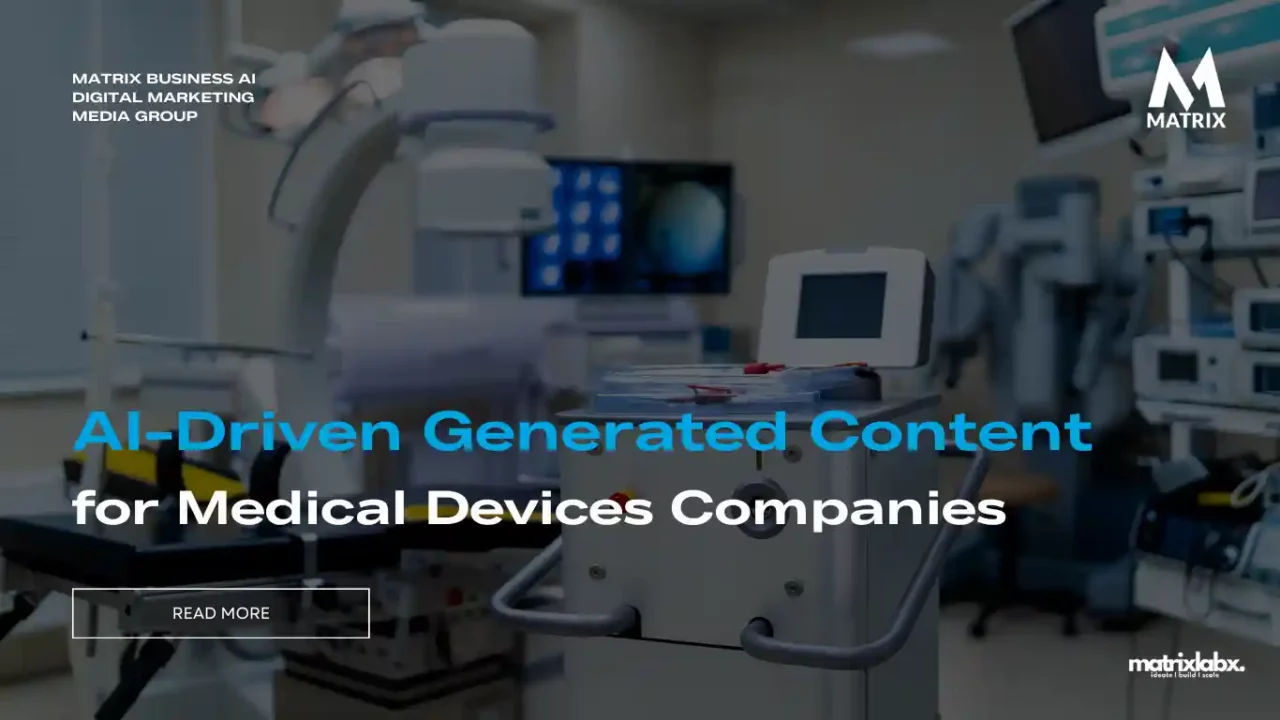AI-Driven Generated Content for Medical Devices Companies
Learn How to AI-Driven Generated Content for Medical Devices Companies
Introduction to AI-Driven Generated Content for Medical Devices Companies
In today’s fast-paced digital age, the need for high-quality content creation has never been greater, especially for medical device companies.
To effectively engage with their target audience, these companies must not only provide accurate and up-to-date information but also ensure that their content is engaging and relevant.
This is where AI-driven generated content comes into play. With the help of artificial intelligence technology, medical device companies can now create compelling content tailored to their specific needs and audiences.
In this article, we will explore the benefits and challenges of AI-driven generated content for medical device companies and discuss how this technology can revolutionize content creation in the industry. Content Translation Services: A Competitive Advantage for Your Business

1. Understanding AI-driven content generation
Artificial intelligence, or AI, refers to the ability of machines to mimic human cognitive functions, such as understanding, learning, and reasoning.
When it comes to content generation, AI algorithms can analyze vast amounts of data and generate accurate and coherent text that is similar to what a human would write.
This technology uses natural language processing and machine learning techniques to understand the context and intent behind the content, resulting in high-quality output.
2. The benefits of AI-driven content generation

2.1 Increased efficiency and productivity
One of the primary benefits of AI-driven content generation is the ability to automate the content creation process.
With AI algorithms handling the bulk of the work, medical device companies can save time and resources that would otherwise be spent on manual content production.
This allows them to focus on other important aspects of their business, such as research and development, marketing, and customer support.
2.2 Improved accuracy and consistency
AI-driven content generation ensures that the information provided is accurate and consistent. Machines are not prone to human errors or bias, and they can analyze large volumes of data in a fraction of the time it would take a human to do so.
This results in content that is factually correct and free from subjective opinions, providing a reliable source of information for medical device companies and their customers. AI Product Management: Why Software Product Managers Need to Understand AI and Machine Learning
2.3 Tailored content for specific audiences
With AI-driven content generation, medical device companies can deliver personalized and relevant content to their target audience.
By analyzing user data and preferences, AI algorithms can generate content that is tailored to the needs and interests of individual customers.
This helps companies build stronger connections with their audience and increase customer engagement.
3. Challenges of AI-driven content generation
3.1 Ensuring Ethical Content Creation
While AI-driven content generation offers numerous benefits, it also raises concerns about ethical considerations.
Machines are not equipped with human values and ethics, and there is a risk of generating content that may be misleading or biased.
Medical device companies need to carefully monitor and review the output of AI algorithms to ensure that the generated content meets ethical standards and provides accurate and unbiased information. AI Marketing Plan for Manufacturing Businesses
The Food and Drug Administration (FDA) has issued several guidance documents on the ethical creation of content for medical devices. These guidance documents help manufacturers ensure that their content is accurate, balanced, and not misleading.
One of the most important things that medical device manufacturers can do to ensure the ethical creation of content is to have a process in place to review and approve all content before it is published. This process should involve a team of experts, including clinicians, scientists, and marketing professionals.
The review team should consider the following factors when evaluating content:
- Is the content accurate and up-to-date?
- Is the content balanced, and does it present all sides of the story?
- Is the content free of misleading or deceptive claims?
- Is the content appropriate for the intended audience?
The FDA has also issued guidance on using testimonials and endorsements in medical device marketing. Manufacturers should be careful not to use testimonials or endorsements that are misleading or deceptive. Testimonials and endorsements should be from real patients or healthcare professionals, and they should be based on personal experience with the medical device.
In addition to following the FDA’s guidance documents, medical device manufacturers should adhere to ethical principles when creating content. These principles include honesty, transparency, and respect for the patient.
Here are some specific steps that medical device manufacturers can take to ensure the ethical creation of content:
- Have a clear and concise editorial policy. This policy should outline the company’s standards for accuracy, balance, and fairness.
- Use a team of experts to review and approve all content. This team should include clinicians, scientists, and marketing professionals.
- Be careful not to use misleading or deceptive claims. Content should be based on sound scientific evidence and should not make promises that the medical device cannot deliver.
- Be transparent about the source of all information. This includes disclosing any financial or other relationships with the authors or contributors to the content.
- Respect the privacy of patients. Do not use any patient testimonials or endorsements without the patient’s prior written consent.
By following these steps, medical device manufacturers can help to ensure that their content is ethical, accurate, and balanced.
3.2 Maintaining brand voice and identity
Another challenge of AI-driven content generation is maintaining the brand voice and identity of medical device companies.
Content plays a crucial role in shaping a company’s image and perception in the market. Companies need to ensure that the content generated by AI algorithms aligns with their brand values and messaging. Content Marketing Financial Firms
This requires ongoing monitoring and fine-tuning to maintain consistency and coherence in the generated content.
To control the corporate brand voice and identity throughout the organization, you must:
- Define and document your brand voice and identity. This should include a clear and concise description of your brand’s personality, values, and tone of voice. You should also create a brand style guide that provides specific guidance on using your brand voice and identity in different contexts.
- Communicate your brand voice and identity to your employees. Ensure all employees understand your brand’s personality, values, and tone of voice. You can do this through training sessions, workshops, and internal communications.
- Create a process for reviewing and approving all brand communications. This process should ensure all brand communications align with your brand voice and identity.
- Monitor and measure your brand voice and identity. Use social media listening and analytics tools to track how the public perceives your brand voice and identity. This information can help you to make necessary adjustments to your brand voice and identity over time.
Here are some specific things you can do to implement these steps:
- Create a brand bible. This is a document that outlines your brand voice and identity in detail. It should describe your brand’s personality, values, tone of voice, and visual identity. The brand bible should be distributed to all employees and used as a reference for all brand communications.
- Develop brand voice guidelines. These guidelines should provide specific guidance on how to use your brand voice in different contexts, such as Social media, marketing materials, and customer service interactions. The brand voice guidelines should be easy to understand and should be accessible to all employees.
- Provide training on brand voice and identity. All employees should be trained on your brand voice and identity. This training should cover the basics of your brand, such as its personality, values, and tone of voice. It should also cover how to use your brand voice in different contexts.
- Create a brand review process. This process should ensure all brand communications align with your brand voice and identity. The brand review process should involve multiple stakeholders, such as marketing, sales, and customer service.
- Monitor and measure your brand voice and identity. Use social media listening and analytics tools to track how the public perceives your brand voice and identity. This information can help you to make necessary adjustments to your brand voice and identity over time.
By following these steps, you can control your corporate brand voice and identity throughout the organization. This will help you to create a strong and consistent brand experience for your customers.
3.3 Balancing automation with a human touch
While AI-driven content generation can automate content creation, it is important to balance automation and the human touch.
Content that is solely generated by machines may lack the creativity and emotional connection that human writers can provide. Content Marketing for Construction Companies: 5 Easy Steps to More Projects
Medical device companies need to find the right balance between automation and human input to ensure that the generated content is both informative and compelling.
4. Implementing AI-driven content generation for medical device companies

4.1 Data gathering and analysis
The first step in implementing AI-driven content generation is to gather and analyze relevant data. Medical device companies should collect user data, industry trends, and competitor analysis to understand the needs and preferences of their target audience.
This data will serve as the basis for training AI algorithms and generating content that is tailored to the specific requirements of the audience.
I need complete market research and analysis to understand the [type of product or service] industry and identify potential opportunities and challenges include a list of key competitors, unique value proposition, customer list, and other research.
4.2 Selecting the Right AI Tools and Platforms
There are numerous AI tools and platforms available for content generation. Medical device companies should carefully evaluate and select the tools that align with their business needs and objectives.
It is important to consider factors such as ease of use, customization options, and integration capabilities with existing systems.
To select the right AI tools and platforms for a medical device business, you need to consider the following factors:
- Your business needs. What specific challenges or tasks do you want AI to help you with? Do you want AI to improve product development, clinical trials, or patient care?
- Your data. AI tools and platforms require data to train and operate. Do you have the necessary data available? Is your data of high quality and in a format that AI tools can easily use?
- Your budget. AI tools and platforms can range in price from free to millions of dollars. It is important to choose a solution that fits your budget.
- Your expertise. Do you have the necessary expertise to implement and use AI tools and platforms? If not, you may need to hire external help.
Once you have considered these factors, you can evaluate specific AI tools and platforms. There are several different AI tools and platforms available, each with its strengths and weaknesses. It is important to compare different solutions to find the one that is right for your business.
Here are some specific steps you can take to select the right AI tools and platforms for your medical device business:
- Identify your business needs. What specific challenges or tasks do you want AI to help you with? Do you want AI to improve product development, clinical trials, or patient care? Once you have identified your business needs, you can start to look for AI tools and platforms that can help you achieve your goals.
- Assess your data. AI tools and platforms require data to train and operate. Do you have the necessary data available? Is your data of high quality and in a format that AI tools can easily use? If not, you may need to collect more data or clean up your existing data.
- Set a budget. AI tools and platforms can range in price from free to millions of dollars. It is important to set a budget for AI before you start evaluating different solutions. This will help you to narrow down your options and choose a solution that is affordable.
- Evaluate different solutions. There are a number of different AI tools and platforms available. It is important to compare different solutions to find the one that is right for your business. Consider the following factors when evaluating different solutions:
- Features and functionality: Does the AI tool or platform have the features and functionality that you need?
- Ease of use: Is the AI tool or platform easy to use and implement?
- Scalability: Can the AI tool or platform scale as your business grows?
- Security and compliance: Does the AI tool or platform meet your security and compliance requirements?
- Support: Does the AI tool or platform come with good support?
- Get a free trial or demo. Many AI tools and platforms offer free trials or demos. This is a great way to try out different solutions before you commit to a paid plan.
- Talk to other users. Talk to other medical device businesses that are using AI tools and platforms. Get their feedback on the solutions they are using and what they like and dislike about them.
By following these steps, you can select the right AI tools and platforms for your medical device business. This will help you to achieve your business goals and improve your bottom line.
Examples of AI tools and platforms used by medical device businesses:
- Product development: AI can improve product development by automating tasks such as data analysis, design, and testing. AI can also be used to generate new product ideas and to identify potential risks and challenges.
- Clinical trials: AI can improve clinical trials by automating tasks such as data collection, analysis, and reporting. AI can also be used to identify and recruit patients and to monitor patient safety.
- Patient care: AI can improve patient care by providing personalized treatment plans, predicting patient outcomes, and monitoring patient health. AI can also be used to develop new diagnostic tools and treatments.
If you are considering using AI in your medical device business, it is important to select the right tools and platforms carefully. By following the steps above, you can choose a solution that is right for your business needs and budget.
4.3 Training and fine-tuning AI algorithms
Once the AI tools and platforms are selected, medical device companies must train and fine-tune the AI algorithms to generate accurate and relevant content.
This involves providing the algorithms with high-quality data and feedback to improve performance continuously.
It is an ongoing process that requires regular monitoring and adjustments to ensure optimal results.
Train and fine-tune AI algorithms in Google’s Vertex AI
You can follow these steps:
- Prepare your data. Vertex AI supports various data formats, including CSV, JSON, and TFRecord. Make sure that your data is formatted correctly and that it is split into training, validation, and test sets.
- Choose a training framework. Vertex AI supports a variety of training frameworks, including TensorFlow, PyTorch, and XGBoost. Choose a training framework that is appropriate for your AI algorithm.
- Create a training job. A training job specifies the training framework, the hyperparameters, and the data to use for training. You can create a training job using the Vertex AI console or the Vertex AI Python client library.
- Submit the training job. Once you have created a training job, you can submit it to Vertex AI. Vertex AI will automatically provision the necessary computing resources and start training your AI algorithm.
- Monitor the training job. You can monitor the progress of the training job using the Vertex AI console or the Vertex AI Python client library.
- Evaluate the trained model. Once the training job is complete, you can evaluate the trained model on the validation set. If the model performs well on the validation set, you can deploy it to production.
To fine-tune an AI algorithm in Vertex AI, you can follow these steps:
- Load the pre-trained model. You can load a pre-trained model from Vertex AI or from another source.
- Create a fine-tuning dataset. A fine-tuning dataset is a small dataset that is used to fine-tune the pre-trained model. The fine-tuning dataset should be representative of the data that the model will be used to predict on in production.
- Create a fine-tuning job. A fine-tuning job specifies the pre-trained model, the fine-tuning dataset, and the hyperparameters. You can create a fine-tuning job using the Vertex AI console or the Vertex AI Python client library.
- Submit the fine-tuning job. Once you have created a fine-tuning job, you can submit it to Vertex AI. Vertex AI will automatically provision the necessary computing resources and start fine-tuning the pre-trained model.
- Monitor the fine-tuning job. You can monitor the progress of the fine-tuning job using the Vertex AI console or the Vertex AI Python client library.
- Evaluate the fine-tuned model. Once the fine-tuning job is complete, you can evaluate the fine-tuned model on the validation set. If the model performs well on the validation set, you can deploy it to production.
Vertex AI also provides a number of features to help you train and fine-tune AI algorithms more efficiently, including:
- Hyperparameter tuning: Vertex AI can automatically tune the hyperparameters of your AI algorithm to improve its performance.
- Distributed training: Vertex AI can distribute the training of your AI algorithm across multiple machines to reduce the training time.
- Early stopping: Vertex AI can automatically stop the training of your AI algorithm if it is not improving on the validation set.
- Model checkpoints: Vertex AI can save checkpoints of your AI algorithm during training. This allows you to resume training from a checkpoint if the training job fails or if you want to try different hyperparameter settings.
By using the features provided by Vertex AI, you can train and fine-tune AI algorithms more efficiently and effectively.
4.4 Monitoring and Quality Control
To maintain the quality of generated content, medical device companies should establish a robust monitoring and quality control process.
This includes reviewing and editing the output of AI algorithms to ensure accuracy, coherence, and adherence to ethical standards.
Human editors and subject matter experts are critical in this process, providing the necessary human touch and expertise.
Conclusion
AI-driven generated content can revolutionize content creation for medical device companies. By leveraging artificial intelligence technology, these companies can increase efficiency, improve accuracy, and deliver personalized content to their target audience.
However, ethical considerations and maintaining brand identity must be carefully addressed.
With proper implementation and monitoring, AI-driven generated content can help medical device companies establish themselves as trusted sources of information and drive customer engagement in the digital landscape.





